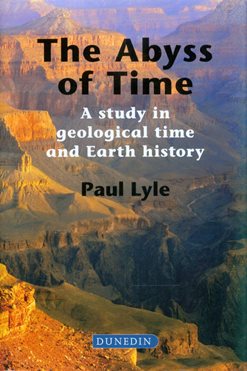
The Abyss of Time
In his latest book, Paul Lyle presents a learned, well-designed and readable account of time in a geological context, drawing its title from James Playfair’s famous aphorism when reflecting on the enormous length of time revealed by the Siccar Point unconformity. It might perhaps have been subtitled ‘The intelligent person’s guide to eternity’, as its intended audience is those with a general interest in the natural world, its development and its future.
Specifically it is aimed at those making environmental and development policy who should be better informed of the temporal and geological contexts of their decisions. Plentifully illustrated with well-chosen good quality examples, it would also be a valuable source for introductory geology courses and for those working in the peripheral areas of the Earth sciences.
Lyle recounts how our thinking about deep time developed historically in the different perspectives of those who have contemplated it, from the ancient and medieval philosophers, through James Hutton and the Scottish Enlightenment, to the famous geologists and theorists of more recent times.
He reviews the formative debate about uniformitarianism and catastrophism, introduces the concepts of time’s arrow and time’s cycle and presents an elegant and succinct overview of the processes working on and within our planet, as we now understand them.
He describes the Earth’s development since the beginning, using time as a framework to explain the changes wrought on the Earth both by slow earth processes and by isolated events. Finally he examines contemporary phenomena, both natural and anthropogenic, and applies plate tectonic theory to peer further into the future. In the great scheme of things, while some may think of Man as the most significant being on Earth, we are left perhaps to infer that our effect on the planet itself and its ultimate future is likely to be negligible in the very long run.
Tangentially, useful and informative accounts are presented of methods of dating, from semi-quantitative approaches of sedimentology and palaeontology, to quantitative radiometric, dendrological and magnetostratigraphic methods.
Paul Lyle has spent a lifetime contemplating, teaching and writing about the unusually varied geology of the north of Ireland. For recreation he translates the poetry of Ancient Greece. Here he presents a philosophical account of the life of the Earth and reassures those who agonise over the ‘future of the planet’ that the Earth will indeed continue to change and life to evolve, with or without our own transitory species, and despite its behaviour.
Reviewed by Mike Young
THE ABYSS OF TIME by PAUL LYLE, 2015. Published by: Dunedin Academic Press 204pp (hbk) ISBN: 9781780460390 List price: £24.99. W: www.dunedinacademicpress.co.uk.
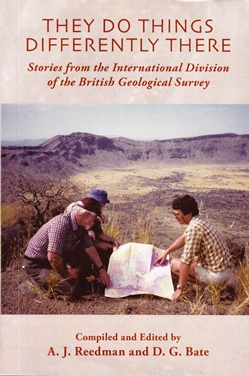
They do things differently there
The past is indeed a foreign country, to misquote L P Hartley, and here is a little book which amply illustrates that point.
This short paperback is the sort of thing you might pack to read on a journey, and it is like going backstage at a theatre to watch the background activity during a play; only the play is the work of geologists of the Overseas Geological Survey during the 1960s onwards.
It is not actually a book about geology or even the geologists themselves, but the anecdotes of those people as they went about their tasks, during what sounds today like a pioneering era. A time which paid little heed, it would seem, to health and safety, processes, technology or anything other than just trying to get on with the job with paper and pencil, manhandling barrels of fuel, and otherwise flying by the seats of their pants.
I remember hearing some of these stories from the ‘horse’s mouth’ while I was on brief secondments from IGS in the 1970s, and it is a delight that they have now put some of the stories on paper for others to enjoy and chew over.
This may be inspirational to some aspiring geologists, so it might be of proffered at careers events; it will probably be valued for the historical context in due time. But for the rest of us we can sit back and just enjoy the descriptions of the travails of a select band of geologists and their support staff travelling the world.
The book is presented as a series of short stories, mapping out the evolution of the service from the 1960s to 2011. For my part I don’t think we do enough of this sort of thing; just who were the personalities who worked for our geological institutions? If there is a weakness with this book it is that there are too few photographs and background of the geologists themselves.
With the advantage of hindsight, our society is clearly living off the fruits of their labour, so perhaps we would do well to reflect upon some of their efforts.
Reviewed by Arthur Tingley
THEY DO THINGS DIFFERENTLY THERE – STORIES FROM THE INTERNATIONAL DIVISION OF THE BRITISH GEOLOGICAL SURVEY by A J REEDMAN & D G BATE (Eds). 2016 Aspect Design. 338pp, sbk. ISBN 978-1908832894 List Price: £12.99. W: Aspect Design
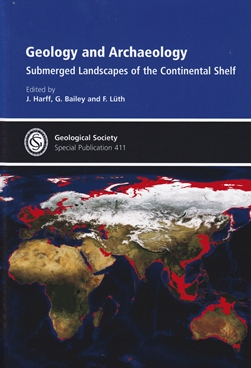
Geology and Archaeology - Submerged Landscapes of the Continental Shelf
Changes in sea-level have been a major control on global human populations since the appearance of our species. Marine regression and transgression from significant climatic change and corresponding glacio-isostatic rearrangements alter the geography of the continental shelf, modifying the viability of environments suitable to human activity, development or migration, distorting interpretation of any potential archaeological record. A topical multidisciplinary field of research, this Special Publication synthesises the current insights within this relatively recent area of underwater geoscientific investigation.
With an overview introducing the subject context, the volume contains three regionally-based thematic sections of 13 papers from research presented at the 34th International Geological Congress, Brisbane, Australia in August 2012. Selected case studies from geographic regions with differing combinations of sea-level histories and crustal movements cover the present geoscientific understanding and technological challenges in submerged landscape reconstruction and assessing archaeological site potential.
Regions influenced by cycles of glacio-isostatic submergence / rebound and associated interactions between sea-level change and glacial history are included from the northern European Fennoscandian Shield and Baltic. Tectonically active areas with complex inter-plate kinematics producing highly variable patterns of uplift, subsidence and topography, are represented by case studies from the Mediterranean. Continental shelves with relatively stable cratons (with minimal tectonic or isostatic influences) are documented by case studies from Australia and South Africa.
Similar research themes within each regional category are inevitable, but particular emphasis is placed upon topics that intersect these geographic ‘boundaries’. Advances in the discovery, interpretation and reconstruction of submerged palaeolandscapes and developments in predictive modelling, coupled with the integration of geological, palaeoenvironmental and archaeological evidence, have provided significant insights into the patterns of human activity and population dispersal at several key locations.
All sections are well written and edited, concisely laid-out with clear and appropriate figures, photographs and data-tables. Many are presented in colour and enhance the understanding of the textual details. The volume is a comprehensive contribution to the field, and the editors are to be congratulated. The primary readership is anticipated to be practising geoscientific professionals and graduate students within this ‘emerging’ research discipline. A recommended read and reference work.
Reviewed by Mark Griffin
GEOLOGY AND ARCHAEOLOGY – SUBMERGED LANDSCAPES OF THE CONTINENTAL SHELF by J HARFF, G BAILEY AND F LÜTH (editors). Geological Society of London Special Publication No 411. 2016. ISBN 978-1-86239-691-3. Hbk. 294pp. List Price: £110.00, www.geolsoc.org.uk.
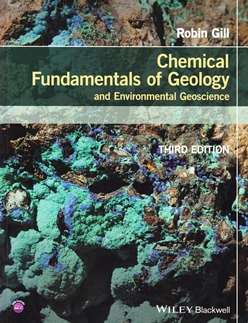
Chemical Fundamentals of Geology and Environmental Geoscience
Since the first appearance in 1989 of ‘Chemical Fundamentals of Geology’, Robin Gill’s textbook has become an established introduction to aspects of geochemistry familiar to undergraduate students of the Earth sciences.
Developed from the second edition, this revised volume retains the same overall structure and is presented in three main sections. The introductory first section (Chapters 1 to 4) outlines the basic scientific principles of physical chemistry appropriate to geological and environmental systems and processes. Particular emphasis is properly placed upon energetic considerations. Chapters 5 to 8 introduces the wave – mechanical view of atoms and types of chemical bonding that govern the distinctive properties displayed by minerals, melts and fluids.
The final section (Chapters 9 to 11) describes the chemistry of geological and environmentally significant elements, introduces the basics of isotope geochemistry and concludes with a chapter outlining element abundance and distribution on Earth and within the wider context of the Universe as a whole.
Demonstrated by the amended title, the third edition now emphasises the chemical foundations of environmental Earth science together with mainstream (or ‘traditional’) geology. This content modification mirrors the recent increase in student interest and the number of undergraduate courses now currently available in this subject area. The inclusion of a new chapter introducing basic isotope geochemistry highlights the importance of the application of isotope systems to the understanding of geological and environmental processes.
Most chapters have review exercise sections with answers provided in a separate glossary that aid the understanding of the chemical concepts outlined in the corresponding text. Textual ‘boxed sections’ are included for more advanced or interested readers. Appendices revising basic mathematical concepts, simple solution chemistry and chemical / element data-tables, (including symbols, units and constants used in the text) are also presented.
Gill’s revised edition continues to provide a solid and readily comprehensible introduction to the scientific principles of chemistry underpinning geology and environmental earth science. It is anticipated to appeal primarily to first year undergraduates in geology, earth and environmental sciences with little or no recent backgrounds in chemistry. The associated companion website allows access to fully downloadable PDF or PowerPoint files of all figures and chemical data-tables in the text, a feature that will enhance both teaching and study.
Reviewed by Mark Griffin
CHEMICAL FUNDAMENTALS OF GEOLOGY AND ENVIRONMENTAL GEOSCIENCE (THIRD EDITION) by ROBIN GILL. Wiley Blackwell. 2015. ISBN 978-0-470-65665-5. Sbk 267pp. List Price: £35.50 W: Wiley Blackwell
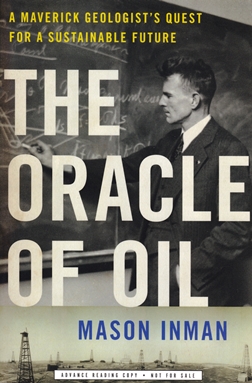
The Oracle of Oil
The Oracle of Oil, Mason Inman has highlighted the life, times and ideas of Marion King Hubbert (1903 - 89), regarded by many within geophysics, a genius. Inman uses the term 'oracle' as someone who gives sound advice and forecasts, and 'maverick' as an independent-minded person who refuses to toe the 'party line'. Others might say 'awkward squad'.
Hubbert came from the poorest Texas backwoods. His degree from the University of Chicago covered geology, physics and mathematics, but when he graduated had published three classic papers on geoscience. He had also worked many unpleasant hours just to pay his tuition fees. He developed a state-of-the-art university course on subterranean geophysics before joining Shell Oil in Houston in 1943 as 'technical coordinator'. On promotion, he helped grow their Bellaire Research Laboratories. He retired in 1964, and moved to the US Geological Survey, retiring again in 1976.
Throughout the chapters we get snippets of his scientific genius. He developed and published mathematically rigorous theories of fluid flow in porous media defining fluid potential, hydrodynamic trapping of oil in reservoirs, hydraulic fracturing, plasticity of rocks, overthrust faults, and much more. He gave many external lectures and had positive ideas on solar energy, climate change and nuclear energy, which became blunted because of the then cavalier disposal of waste.
In 1956 he gained notoriety for his in-depth analysis of oil reserves. He predicted that overall US petroleum production would soon peak and decline thereafter, illustrated in a bell-shaped curve - 'Peak Oil theory'. Many dismissed it, believing that the apparent plenty would last. However before Hubbert's death, his pronouncements were coming true and the US was importing much oil. An Epilogue updates us to 2012, where shale gas and oil have come to the rescue: but look what has happened since!
Inman walks us through King Hubbert's life giving us fascinating insights which illustrate why he gained reputation, clashes, many ground-breaking papers, accolades and honours. In particular we learn of his conflicts with academics, energy policy makers, oil companies, government agents and politicians.
I found The Oracle of Oil a page-turner. Hubbert's persistence for intellectual honesty and rigour and the challenges with the naysayers come across splendidly. The book and bibliography could be a valuable source for scientific historians and energy policymakers to get a flavour of the antipathetic atmosphere often surrounding him, particularly peak oil, and for anybody who wants an engaging read: no equations… just the peak curve.
Reviewed by Richard Dawe
THE ORACLE OF OIL: A MAVERICK GEOLOGIST'S QUEST FOR A SUSTAINABLE FUTURE by MASON INMAN, 2016. Published by: W W Norton & Company, Inc. 432pp., hbk, ISBN: 9780393239683. List price: £20, W: www.norton.co.uk.